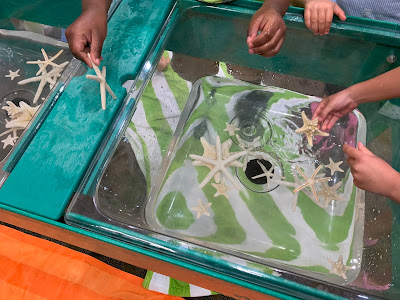
Halloween is full of sensory experiences. The eerie orange and purple lights, slimy pumpkin guts, tasty pumpkin seeds and candy, and of course the spooky sounds coming from the creatures in the night. Ms. Patricia and I brought a few of these sensory treats with us on our visit to the Wing Lake Developmental Center (see previous posts about Wing Lake) for their Halloween festival on October 31.
Here's the plan:
1. Hello (Talk about Picture Schedule)
2. Talk about theme: "Today is Halloween! What do you like about Halloween? (treats, spooky things like scarecrows and jack-o-lanterns, colorful leaves) Did you go trick-or-treating in school today?
3. Story: Scarecrow, Scarecrow, What Do You See? by Lisa Erwin, SLP
This is an adapted book with interactive images. I enlarged this book and interactive image pieces to poster-size, looped ring clips through the top and attached it to our portable easel to flip through.
(source: My Speech Tools)
4. Flannel rhyme: "Halloween, Who's at My Door?"
Halloween, Halloween -- who will come a-knocking?
Halloween, Halloween -- who will come a-knocking?
Halloween, Halloween -- who will come a-knocking?
Who will you see at your door?
Knock, knock, knock -- it's a ghost that's a-knocking...
Knock, knock, knock -- it's a jack-o-lantern a-knocking...
Knock, knock, knock -- it's a black cat a-knocking...
That's who you see at your door!
(source: unknown)
5. Story with sensory experiences: Shivery Shades of Halloween: A Spooky Book of Colors by Mary McKenna Siddals (available in eBook format for projecting!)
This book is such a fantastic example of sensory storytelling! Each 2-page spread is a different color's sensory experiences ("Halloween is green...slimy-grimy, queasy-peasy, snotty-rotty tinge of green.")
We brought these colorful sensations around to each student to see, touch, smell, and/or hear:
Green: bowls of jello slime
Purple: furry purple monster puppet with squeaker mouth
White: cobwebs (pieces of artificial spider webs found in stores around Halloween)
Gray: tombstones (Styrofoam tombstones from the Halloween store)
Blue: bubbles
Yellow: glowing eyes (cardboard tubes with eye-shaped cut outs wrapped in black duct tape to contrast with the yellow glow sticks inside)
Brown: small tree branches
Black: cauldron and black bat puppet
Red: silky scarves that looked like the vampire's cape
Orange: pumpkins

6. Goodbye Song: "If You're a Monster and You Know It"
(tune: "If You're Happy and You Know It")
If you're a monster and you know it,
wave your arms.
If you're a monster and you know it,
wave your arms.
If you're a monster and you know it,
then your arms will surely show it.
If you're a monster and you know it,
wave your arms.
Additional verses: show your teeth, roar out loud
(source: preschooleducation.com)
7. Craft: Squishy Jack-O-Lanterns
Our clerical assistant, Diana, traced the outline of a jack-o-lantern on 100 large ziploc bags for us. Each student and aids were given one of these bags along with squirts of orange finger paint inside. Bags were sealed and then students could squish the paint around to color the jack-o-lantern orange.

























































